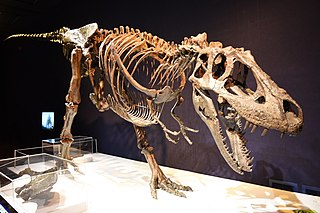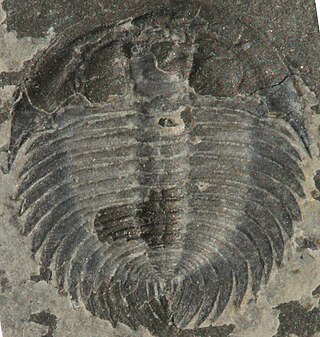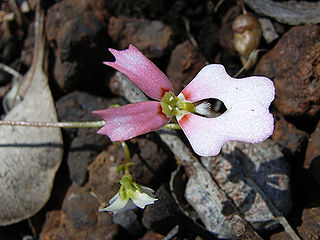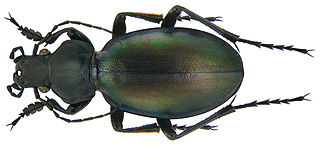
Daspletosaurus is a genus of tyrannosaurid dinosaur that lived in Laramidia between about 78 and 74.4 million years ago, during the Late Cretaceous Period. The genus Daspletosaurus contains three named species. Fossils of the earlier type species, D. torosus, have been found in Alberta, while fossils of a later species, D. horneri, have been found only in Montana. D. wilsoni has been suggested as an intermediate species between D. torosus and D. horneri that evolved through anagenesis, though further research may be required to definitively support the theory.

Corynexochida is an order of trilobite that lived from the Lower Cambrian to the Late Devonian. Like many of the other trilobite orders, Corynexochida contains many species with widespread characteristics.

Deinodon is a dubious tyrannosaurid dinosaur genus containing a single species, Deinodon horridus. D. horridus is known only from a set of teeth found in the Late Cretaceous Judith River Formation of Montana and named by paleontologist Joseph Leidy in 1856. These were the first tyrannosaurid remains to be described and had been collected by Ferdinand Vandeveer Hayden. The teeth of Deinodon were slightly heterodont, and the holotype of Aublysodon can probably be assigned to Deinodon.

Aguarunichthys is a genus of long-whiskered catfishes native to South America.

The Rocky Mountain Dinosaur Resource Center is a fossil museum primarily exhibiting fossil organisms of North America's Late Cretaceous including dinosaurs, pterosaurs, marine reptiles, and fish. The museum includes a fossil preparation lab and a large gift shop. Live tours are delivered by visitor experience guides highlighting the history of the individual specimens as well as the paleontology of the fossil species they represent. The RMDRC is headquarters to its parent company, Triebold Paleontology Incorporated.

Sisor is a genus of catfishes native to Asia.

Stylidium subg. Centridium is a subgenus of Stylidium that is characterized by a globose hypanthium, a stipitate brush-like stigma, and gynostemium mobility not produced by a sensitive hinged torosus but by the movement of a cunabulum. All species with the possible and doubtful exception of S. weeliwolli are annuals. This subgenus appears to be most closely related to the genus Levenhookia, which suggests an ancestral relationship. Centridium was first published by John Lindley in the 1839 publication, A Sketch of the Vegetation of the Swan River Colony. Lindley created this subgenus to distinguish species which did not fit into either of the two other subgenera that had existed at the time. He initially placed Stylidium calcaratum, the newly described Stylidium androsaceum, and Stylidium stipitatum into subgenus Centridium. His description of S. androsaceum turned out to be synonymous with S. calcaratum and S. stipitatum is a synonym of Levenhookia stipitata.

Suillellus luridus, commonly known as the lurid bolete, is a fungus of the family Boletaceae, found in calcareous broadleaved woodlands in Europe. Fruit bodies appear in summer and autumn and may be locally abundant. It is a firm bolete with an olive-brown cap up to 20 cm (8 in) in diameter, with small orange or red pores on the underside. The stout ochre stem reaches 8–14 cm (3–6 in) high and 1–3 cm (0.4–1.2 in) wide, and is patterned with a red network. Like several other red-pored boletes, it stains blue when bruised or cut.

Proporidae is a family of acoels.

Carabus torosus is a species of black-coloured ground beetle in the Carabinae subfamily that can be found in Bulgaria, European part of Turkey, and Near East.

Imperator torosus, commonly known as the brawny bolete, is a species of bolete fungus in the family Boletaceae. It is native to southern Europe east to the Caucasus and Israel. It is generally associated with deciduous trees such as hornbeam, oak and beech in warm, dry locales. Although generally rare in Europe, it appears to be relatively common in Hungary. Appearing in summer and autumn on chalky soils, the stocky fruit bodies have an ochre cap up to 20 cm (8 in) across, yellow pores on the cap underside, and a wine-red to brown or blackish stipe up to 6–15 cm (2.4–5.9 in) long by 3–6 cm (1.2–2.4 in) wide. The pale yellow flesh changes to different colours when broken or bruised depending on age; younger mushrooms become reddish, and older ones additionally take on bluish tones.

Imperator luteocupreus is a species of bolete fungus in the family Boletaceae. It is native to southern Europe, where it is found under chestnut (Castanea) and oak (Quercus). Although it was originally described in genus Boletus, it was placed in the new genus Imperator in 2015, based on phylogenetic inferences.

Orsonwelles is a genus of American dwarf spiders that was first described by G. Hormiga in 2002. They are all native to the Hawaiian Islands, each species occurring on a single island, often at high elevations. One species has not been collected since the 1890s, and is believed to be extinct. The name honors the actor and film-maker Orson Welles. Many of the species names commemorate elements from Welles' films, radio productions, or roles.

Imperator is a genus of fungi in the family Boletaceae. It was circumscribed in 2015 by Boris Assyov and colleagues. The erection of Imperator follows recent molecular phylogenetic studies that outlined a new taxonomic framework for the Boletaceae.

Orsonwelles torosus is a species of linyphiid spider endemic to Kauai in the Hawaiian Islands. It was described in 1900 by the French naturalist Eugène Simon based on a specimen collected in the 1890s, but has not been collected since, and is presumed extinct.

Thanatotheristes is a genus of tyrannosaurid dinosaur from the Late Cretaceous of Laramidia, approximately 80.1-79.5 Ma. Thanatotheristes contains only one species, T. degrootorum. Fossils of this taxon are found in the Foremost Formation of Alberta, Canada, coexisting with medium-sized ceratopsids like Xenoceratops foremostensis and small pachycephalosaurids like Colepiocephale lambei.

Daspletosaurini is an extinct clade (tribe) of tyrannosaurine dinosaurs that lived in Laramidia during the Late Cretaceous period. It consists of two genera: Daspletosaurus and Thanatotheristes. Four species have been described in the two genera, namely Daspletosaurus torosus, Daspletosaurus horneri, Daspletosaurus wilsoni, and Thanatotheristes degrootorum. At one point all of them were assigned as specimens of D. torosus, but several papers since 2017 have found them to represent distinct species. Some researchers found anagenesis in the group, whether contained in a daspletosaurin clade or paraphyletic in respect to the lineage of tyrannosaurines leading up to Tyrannosaurus, but a 2023 study refuted this theory on the basis of morphological and stratigraphical data.

Aguarunichthys torosus, the Bolt Catfish or Yellow-band Catfish, is a species of benthopelagic catfish of the family Pimelodidae that is native to Cenepa River basin in Amazon River drainage of Peru.

Trogulus torosus is a species of large harvestman occurring in Bosnia and Herzegovina, Croatia, and Montenegro. It is the largest harvestman in the world by body length, up to 23.2 mm.

Trogulus is a genus of Opiliones in the family Trogulidae. Harvestmen in the genus have large, elongated and flattened bodies and a two-segmented tarsus segment on leg II, which distinguishes them from other genera in the family Trogulidae. The legs tend to be short compared to most harvestmen. External morphology tends to be very uniform across species in the genus, making differentiation of species difficult. Species occur in a range of habitats, but are most common in forests where their primary prey, snails, are abundant. Trogulus contains the largest known harvestman by body length, Trogulus torosus.

















